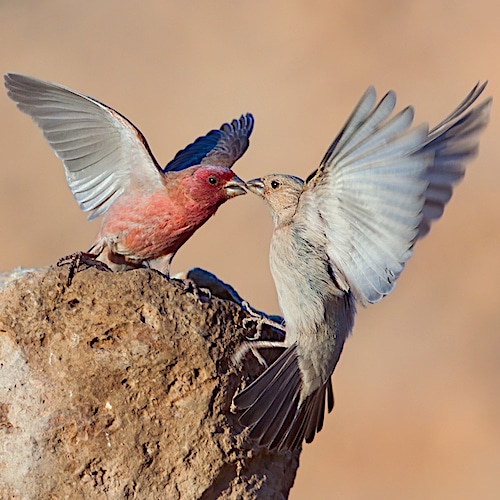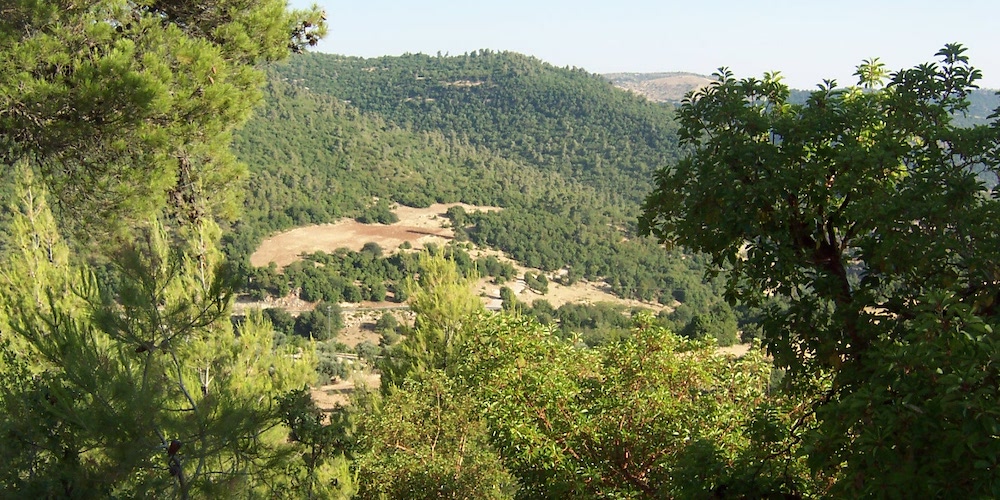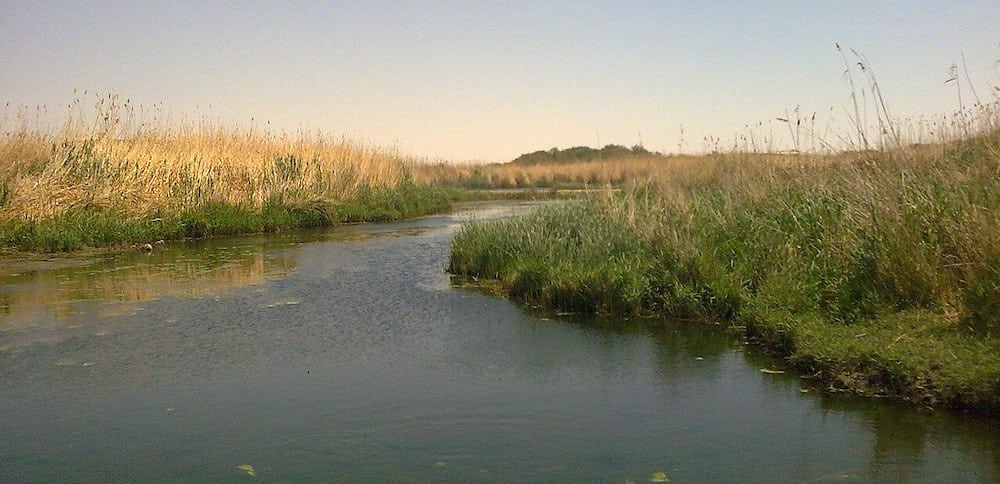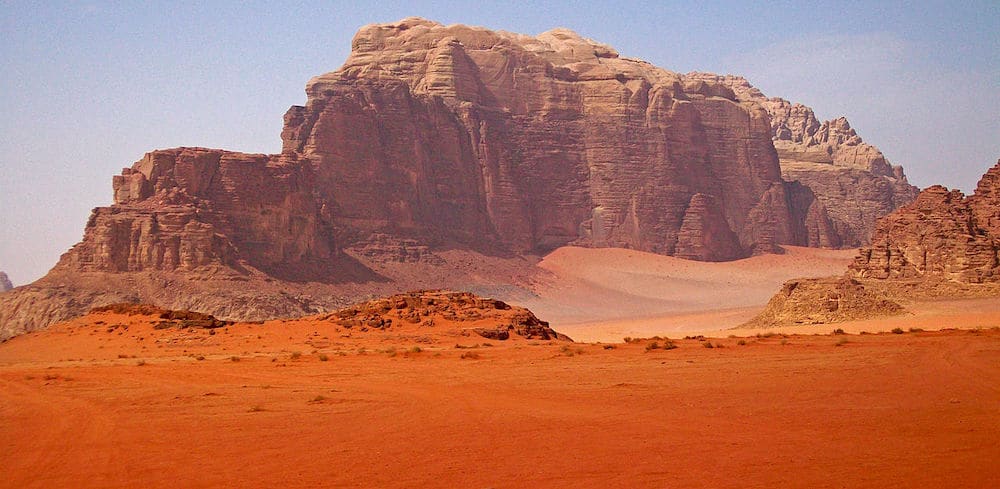The Hashemite Kingdom of Jordan

Jordan is a country in the Southern Levant region of West Asia with a population of around 11.3 million people. It sits strategically at the crossroads of the continents of Asia, Africa and Europe in the Levant area of the Fertile Crescent, a cradle of civilization. Covering just under 90,000 k2 (35,000 square miles), it is bordered by Syria to the north, Iraq to the east, Saudi Arabia to the south, and Israel and the occupied Palestinian West Bank to the west. It is around 400 kilometres (250 miles) long between its northernmost and southernmost points; Umm Qais and Aqaba respectively. The Jordan River, flowing into the Dead Sea, is located along the country’s western border. Jordan has a small coastline along the Red Sea in its southwest, separated by the Gulf of Aqaba from Egypt.
Amman is Jordan’s capital and largest city with around 2.25 million inhabitants, making it the most populous city in the Levant. Major cities are overwhelmingly located on the north-western part of the kingdom due to its fertile soils and relatively abundant rainfall. These include Irbid, Jerash and Zarqa in the northwest, Amman and As-Salt in the central west, and Madaba, Al-Karak and Aqaba in the southwest. The east is an arid plateau irrigated by oases and seasonal water streams. Major towns in the eastern part of the country are the oasis towns of Azraq and Ruwaished. In the west, a highland area of arable land and Mediterranean evergreen forestry drops suddenly into the Jordan Rift Valley. The rift valley contains the Jordan River and the Dead Sea, which separates Jordan from Israel.
Jordan has a 26 kilometre (16 mile) shoreline on the Gulf of Aqaba in the Red Sea, but is otherwise landlocked. The Yarmuk River, an eastern tributary of the Jordan, forms part of the boundary between Jordan and Syria (including the occupied Golan Heights) to the north. The other boundaries are formed by several international and local agreements and do not follow well-defined natural features. The highest point is Jabal Umm al Dami, at 6,083 feet above sea level, while the lowest is the Dead Sea at −1,378 feet, the lowest land point on Earth.
Jordan has a diverse range of habitats, ecosystems and biota due to its varied landscapes and environments. The Royal Society for the Conservation of Nature was set up in 1966 to protect and manage Jordan’s natural resources. Nature reserves in Jordan include the Dana Biosphere Reserve, the Azraq Wetland Reserve, the Shaumari Wildlife Reserve and the Mujib Nature Reserve.
The climate in Jordan varies greatly. Generally, the further inland from the Mediterranean, there are greater contrasts in temperature and less rainfall. The highlands above the Jordan Valley, mountains of the Dead Sea and Wadi Araba and as far south as Ras Al-Naqab are dominated by a Mediterranean climate, while the eastern and northeastern areas of the country are arid desert. Although the desert parts of the kingdom reach high temperatures, the heat is usually moderated by low humidity and a daytime breeze, while the nights are cool. Summers, lasting from May to September, are hot and dry, with temperatures averaging around 32 °C and sometimes exceeding 40 °C between July and August. The winter, lasting from November to March, is relatively cool, with temperatures averaging around 11 °C Winter also sees frequent showers and occasional snowfall in some western elevated areas.

Ajloun – ©Smart Viral CC BY-SA 3.0 via Wikimedia Commons
Many of the flowering plants bloom in the spring after the winter rains and the type of vegetation depends largely on the levels of precipitation. The mountainous regions in the northwest are clothed in forests, while further south and east the vegetation becomes more scrubby and transitions to steppe-type vegetation. Forests cover less than 2% of Jordan, making Jordan among the world’s least forested countries, the international average being 15%. Four terrestrial ecoregions lie with Jordan’s borders: Syrian xeric grasslands and shrublands, Eastern Mediterranean conifer-sclerophyllous-broadleaf forests, Mesopotamian shrub desert, and Red Sea Nubo-Sindian tropical desert and semi-desert.
Birding Jordan
With much attention focused on neighbouring Israel, information for birders about Jordan has been sadly lacking. The publication of Ian Andrew’s excellent book in 1995 The Birds of the Hashemite Kingdom of Jordan and his Birding in Jordan website helped put Jordan on the birding map. Ian worked in Jordan for a number of years and collected together records from the small number of birdwatchers and tour companies who had previously visited this fabulous and under-watched country.
Ornithologically, the main difference between birding in Jordan and in Israel, is that you have to find the birds yourself. In contrast with Aqaba (Jordan’s main Red Sea port); very few birds must pass unseen in Eilat (especially during peak migration seasons). With less than a mile between them, the same birds must occur. Any birder in Jordan therefore has a greater chance of ornithological glory! The few Jordanian birdwatchers can often expect to discover new birds for their country or at least major rarities.
The difference in the level of coverage is reflected in the bird lists of these countries – over 500 recorded for Israel but less than 450 for Jordan, although, of course, Israel has a relatively long Mediterranean coast too. Another tempting feature for would-be visitors is the habitat. Eilat regulars are often dismayed by the continued development in the resort, whereas the habitat in Aqaba is fantastic with irrigated allotments running for about one kilometre along the coast and an increasingly famous sewage works (not least because it can almost be viewed from Eilat – but not quite!)
Ornithological understanding has increased substantially since the first of many expeditions took place to establish baseline criteria for Jordan’s wildlife organised by the Royal Society for the Conservation of Nature in Jordan. These were the first expeditions since Guy Mountford et al visited the country in the 1960s. Much of these baseline data were collected by Jordanian/European survey teams including many bird specific surveys.
Although there are plenty of new places to explore in Jordan, there are a number of sites definitely on the birding trail. The country’s position at the top of the rift valley means that migrant birds can be found almost anywhere at the right time of year.
Starting in Amman, most birding itineraries explore the country in two stages. Firstly, heading from the city into the eastern desert, one can expect to start seeing typical desert species but there are several specific sites well worth exploring. The first important stop is Wadi Al Butm – a tree lined wadi worth checking for migrants. Among the more common migrant species, birds such as White-throated Robin and Striated Scops Owl have been reported.

Azraq Wetland Reserve – ©Ldud CC BY 3.0 via Wikimedia Commons
The next stop is Azraq. Now a shadow of its former glories due to water extraction, this desert oasis has enjoyed substantial habitat restoration in the last few years and is now a must for passing birders. With a visitor centre, boardwalk through the reeds and hides, visitors can view the pools easily and can expect to find a good range of wetland birds and passage migrants. The lack of cover in the surrounding stony desert means Azraq pulls in the birds and is responsible for some excellent records in recent years. Highlights have included Ménétries’s Warbler, Egyptian Nightjar and Red-wattled Lapwing. When flooded, the low-lying desert (Qa) to the east of the reserve can hold massive numbers of waterfowl and waders.
Eleven kilometres from Azraq is another RSCN reserve – Shaumari. This is another site able to pull in migrant birds since it again offers substantial cover (scrub and woodland) amid the surrounded desert. The road leading to this oasis allows birders good access to the desert too with Larks and Cream-coloured Coursers regularly seen.

Mujib Nature Reserve – ©hikinginjordan CC BY-SA 3.0 via Wikimedia Commons
Heading further east, the road passes through the town of As Safawi. From here eastwards, you enter the basalt boulder desert. About 9k east of the town, among the more typical larks and wheatears it is worth looking out for the so-called Basalt Wheatear probably a dark form of Mourning Wheatear. The dark morph Desert Lark (subspecies annae) can also be found here. The boulder desert means this area is hard to explore and too far from the road without a four-wheel drive. However, finding these birds near to the road isn’t usually too much trouble. The desert near As Safawi also contains Ammoperdix partridge that could be an undescribed race of See-see rather than the Sand Partridge – but more research is needed.
After exploring the eastern desert, birders usually venture south of the capital into the Jordan Valley. The first stop is usually the Dead Sea where one can find, hardly surprisingly, nesting Dead Sea Sparrows. However, the whole valley area down to As Safi near the southern tip of the Dead Sea is irrigated and provides extensive unexplored habitat. Heading further south, the wadis extending down from the rift margin can be explored using the roads near Fidan. Until recently, access along this road required military permission. Now things are much more straightforward to the east of the road. Caution should be taken around military camps and to the west of the road (the border side). You may be questioned if you wander too close to camps but usually out of curiosity. Best to ask first. This area provides the bird with the usually desert species: Temminck’s, Horned, Hoopoe and Desert Larks. Dunn’s Larks have also been found here.
Heading down to the port of Aqaba, you’re in migrant heaven! At the right times of year, you can expect Collared Flycatchers to be perching on postcard stands, Thrush Nightingales contact calling from under parked cars and explosions of Levant’s Sparrowhawks from bushes and trees as you pass them. No different to Eilat in this respect, but in Aqaba, you will probably be the birder finding these birds. As previously mentioned, the coastal strip is a series of irrigated allotments full of warblers, chats and pipits. Aqaba also has a fantastic sewage works! A sewage works at the top of the Red Sea has to be worth a visit! It is true to say that many of Jordan’s rarest sightings come from this site. Birds are welcome but its situation close to the border makes this a sensitive military area. One has to seek permission to gain access but it is well worth the hassle. Highlights may include Painted Snipe, Cotton Teal, Pink-backed Pelican, Grey-headed Gull and Pacific Golden Plover.

Wadi Rum – ©Daniel Case CC BY-SA 3.0 via Wikimedia Commons
North of Aqaba is Wadi Rum. This is a spectacular area of vast sandstone mesas up to 800m tall. This site has great ornithological significance in Western Palaearctic terms being the only reliable breeding site for Verreaux’s Eagle. Recent birdwatching records suggest that there may be another pair or two in Jordan but your best bet to see this magnificent eagle is to scan the cliffs behind Wadi Rum resthouse. In recent years, seeing a Verreaux’s Eagle has been less than certain, but the hope is that this species maintains it status in Jordan.
Moving further north on the Kings Highway which runs along the rift valley margins, one can visit The RSCN reserve at Dana. This site offers the visitor some of the most spectacular views in the country, looking out over Wadi Araba. Wadi Dana itself leads down into Fidan mentioned earlier but here, at an altitude of 1500m, the habitat is very different. The Barra forest is made up of oak and juniper and holds species such as Tristram’s Serin, Cretzschmar’s Bunting and Sinai Rosefinch. The rocky wadis contain Hume’s, Eagle and Scops Owl. The campsite at Dana is also an excellent place to watch raptor migration. Two Verreaux’s Eagles have been seen here annually since 1999 and with earlier sightings of both adult and juvenile birds, one would think that this area could well hold another pair. It is a wonderful place to stay and most birders spend at least a night here. This is why there are so many excellent bird records from the site like Crested Honey Buzzard and Black Bushchat.
There are many other sites not mentioned here as this is a small sample of some of the key areas. Jordan is one of the most welcoming and safe countries in the Middle East and also very easy to explore. There are several RSCN reserves encompassing a wide range of habitats. Information about visiting and travelling in Jordan can be found in the websites mentioned below. Whilst in Jordan, it is worth putting aside time to visit some cultural sites. Even the most bird focussed visitor would be hard pressed not to find Petra and Jerash breath-taking. Of course, these sites are not without their birding attractions too!
-
Number of bird species: 448
(As at July 2024)National Bird: Sinai Rosefinch Carpodacus synoicus
-
Avibase
PDF ChecklistThis checklist includes all bird species found in Jordan , based on the best information available at this time. It is based on a wide variety of sources that I collated over many years. I am pleased to offer these checklists as a service to birdwatchers. If you find any error, please do not hesitate to report them. -
Jordan Birdwatch
Checklist -
Wikipedia
Annotated ListThis is a list of the bird species recorded in Jordan. The avifauna of Jordan include a total of 448 species, of which 7 have been introduced by humans. 22 species are globally threatened. -
eBird
PDF ChecklistThis checklist is generated with data from eBird (ebird.org), a global database of bird sightings from birders like you. If you enjoy this checklist, please consider contributing your sightings to eBird. It is 100% free to take part, and your observations will help support birders, researchers, and conservationists worldwide.
-
Birds of the Middle East
| By AbdulRahman Al-Sirhan, Jens Eriksen & Richard Porter | Helm | 2022 | Paperback | 224 Pages, 400 Colour Photos | ISBN: 9781472986757 Buy this book from NHBS.com -
Birds of the Middle East
| By Richard Porter, Oscar Campbell & AbdulRahman Al-Sirhan | Helm | 2024 | Edition 3 | 400 pages, 180 colour plates, 636 colour distribution maps | ISBN: 9781399401968 Buy this book from NHBS.com -
The Birds of the Hashemite Kingdom of Jordan
| By Ian J Andrews | Ian Andrews | 1995 | Paperback | 200 pages, 160 photos, 73 illus, 17 distribution maps, migration timing charts | ISBN: 9780952497806 Buy this book from NHBS.com
-
OSME - Ornithological Society Of The Middle East The Caucasus And Central Asia
WebpageTotal number of bird species: 438 Globally threatened bird species: 13 Country endemics: 0
-
BirdLife
WebsiteThe Royal Society for the Conservation of Nature (RSCN) is an independent national organization devoted to the conservation of Jordan's natural resources. RSCN was established in 1966 with His Majesty the late King Hussein as the Honorary President. RSCN has been given the responsibility by the government to care for and protect the Kingdom’s biodiversity. As such, it is one of the few national organizations in the Middle East to be granted such a public mandate. RSCN has gained a wide global fame for its pioneering work in integrating nature conservation programmes with socio-economic development. -
JBRC - Jordan Bird Records Committee
WebpageJBRC was set up in April 1999 to assess records of rare birds in Jordan -
Jordan Birdwatching Club
facebook PageGroup of ornithologists and bird watchers interested in birds of Jordan. A forum to discuss records, status and conservation of birds, and inform about bird watching trips and events in Jordan. The decisions of Jordan Bird Records Committee (JBRC) are also published here -
Jordan Birdwatching Club
WebsiteJordan Birdwatch's goal is to protect wild birds and their habitats in Jordan -
Royal Society for the Conservation of Nature
WebsiteBox 6354, Jubeiha-AbuNusseir Circle, Amman 11183 Jordan. + 962 6 5337931 adminrscn@rscn.org.jo Perhaps the most amazing aspect of nature is the power of one. Each animal, each bird, and each plant plays a key role in the cycle of nature. Likewise, each one of us can contribute to the protection of our environment. -
Wild Jordan
Facebook PageOur main purpose in life is to develop viable nature-based businesses within and around RSCN’s protected areas
-
*Jordan's Nature Reserves
InformationSatellite ViewMany of the birds for which the oasis was renowned are coming back and special boardwalks and bird hides have been constructed to enable visitors to see and enjoy them… -
BR Dana
InformationSatellite ViewDana is located in the southern district of Tafila, about 200 kilometers south of Amman. Due to its wide variety of climate zones (it has mountain heights of 1500 meters and descends to the deserts of Wadi Araba), it is rich in wildlife. But, until recently, development and degradation threatened its biodiversity.… -
NR Azraq Wetlands
InformationSatellite ViewShaumari Wildlife Reserve is located in the eastern Jordanian desert, close to Azraq Wetland Reserve. The geology comprises desert wadis making up 65% of the area and Hammada areas covered in black flint forming 35% of the reserve. Founded in 1975, Shaumari was founded for the wildlife in the desert area. One of the main goals of the reserve has been to bring back locally extinct species, notably the Arabian oryx, into the wild. -
NR Wadi Mujib
InformationSatellite ViewSome iconic and endangered bird species include Lammergeier, Sooty Falcon, Sand Partidge, Hume's Owl, Blackstart, Dead Sea Sparrow and more. Many carnivores also inhabit the various vegetation zones in Mujib, such as the striped hyena and the Syrian wolf. One of the most important animals in Mujib is the Nubian ibex, a large mountain goat which became threatened as a result of over-hunting. -
WR Shaumari
InformationSatellite ViewSome of the species include Arabian oryx, Somali ostriches, Persian onagers (an Asian wild ass from Iran) and gazelles. -
Wetland of International Importance
WebpageSatellite ViewJordan presently has 1 site designated as a Wetland of International Importance, with a surface area of 7,372 hectares.
-
Boletas
Tour OperatorLittle Bittern, Pallid Harrier, Steppe Buzzard, Steppe Eagle, Lesser Kestrel, Sand Partridge, Little Crake, Spur-winged Plover, White-eyed Gull, Laughing Dove, Namaqua Dove, Hume’s Owl, Egyptian Nightjar, Pied Kingfisher, Little Green Bee-eater, Temminck’s Lark, Hoopoe Lark, Rock Martin... -
JordanTours
Tour OperatorTake a good look at a Houbara Bustard, or a Tristram’s Grackle. Our expert guides will reveal the diverse species stopping at the Azraq Oasis Nature Reserve. You will be watching cranes, pelicans, egrets and black headed gulls. The Sinai Rosefinch is the National bird of Jordan, so we will also make it a point to drop in at one of the local habitats of this beautiful rare bird. -
NatureTrek
Tour OperatorTour Code: JOR02A 10-day holiday in search of the specialist mountain birds and migrants to be found amongst some of the country's most dramatic landscapes, plus a visit to the country's most famous archaeological site, Petra. -
Rockjumper
Tour OperatorPetra’s amazing and intricately carved, multi-storey temples and buildings became familiar
-
2017 [05 May] - Erik Forsyth & Cuan Rush - Egypt & Petra
PDF Report...An early start birding around our hotel produced scope looks at a Chukar Partridge posing on a rock and a confiding pair of Palestine Sunbird in the garden. After breakfast we headed for the city of Petra. Petra in Jordan is one of the world’s most remarkable antiquities and regarded as the most astounding ancient city left in the modern world... -
2018 [10 October] - Nick Page
PDF ReportI rarely write trip reports, but there are so few on Jordan available, especially recent, and we want to encourage others to visit this beautiful, friendly and safe destination. Under-birded (we met no other birders), overshadowed by Israel but offering comparable birding. -
2018 [12 December] - Daan Drukker
PDF ReportWith notes how to see more species in spring, during migration and suggestions for a combination with a visit to Israel... -
2019 [01 January] - Sofia Broström
PDF ReportMy son and I visited Jordan during the “marbaniyeh”, i.e., the forty coldest days of winter stretching from the winter solstice to about January 30. We were, however, very lucky with the weather, had no snow or rain and sunny or partially sunny skies every day. -
2023 [03 March] - Olg Zaitseva
PDF ReportNevertheless, already from the apartment terrace we were able to observe some birds in the nearby olive garden. We noticed noisy Common Mynas (Acridotheres tristis, common), Lesser Whitethroats (Curruca curruca, common) were hiding in seemingly every bush and we were delighted to spot the local subspecies of the Eurasian Jay (Garrulus glandarius atricapillus)... -
2023 [10 October] - Thomas Armand
PDF ReportWe arrived at around 2 PM at the airport, we picked up our luggage and our car and we were on our way to Madaba to relax for a bit and to walk around the city. The first new species were quickly seen, such as a Laughing Dove, Rock Martin and Common Myna from the balcony over the hotel pool... -
2023 [10 October] - y Marcus Kohler
PDF Report... A Red-backed Shrike was on the path, and we watched a Sparrowhawk flying over into the sunrise. At the main hide, several Squacco Herons were present, with four Glossy Ibises allowing great views, and a Marsh Harrier sat in a distant tree. An Icterine Warbler flitted at the back of the pool, but we could only identify it when we were able to get a bit closer...
-
Birdwatching
WebsiteBird-watchers from all over the world have started organizing week-long trips to Jordan to enjoy the sight of some rare species of indigenous birds -
Birdwatching in Jordan
WebsiteJordan has a unique location, nestled at the tip of the Arabian Peninsula where the edges of three continents overlap: Asia, Africa and Europe. This small country lies at the heart of major bird migratory routes and has a diverse geology and natural landscape as well, which hosts a large variety of ora and fauna including numerous bird species. Remnants of the rich history of the area are scattered throughout the entire country, and thus most of the main birding sites in Jordan are within or near major tourism attractions. -
Wildlife
WebsiteThe numbers of migrants have decreased as Azraq has grown drier, yet even today up to 220 migratory species continue to transit through Jordan on their journey north or south. The approximately 150 species which are indigenous to Jordan seem not to have been affected greatly by the great drought of the 1980s

